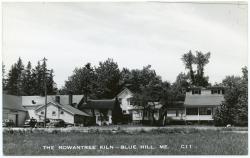The 20th Century Brings New People, Benefactors, and Cultures to Town
At a commemorative clambake in 1886, Captain R.G.F. Candage described the enduring allure of Blue Hill that offset the privations of the first settlers: “….they saw what everyone else has seen who has visited this town, the charm of its situation, its sparkling bay, its inlets, its shores, its landscapes of hill, dale and plain…” The same qualities began to bring summer vacationers to town toward the end of the 19th century. They were eager to leave behind them the heat and the seasonal epidemics of the crowded cities.

Blue Hill Inn construction, Blue Hill, 1892
Blue Hill Historical Society
The Summer Colony. The so-called rusticators came to Blue Hill's summer colony on steamships that met their passengers at the railhead in Rockland. They disembarked at the wharves on Peters’ Point or Parker Point where they might be met by horse-drawn carriages to take them up Tenney Hill to George Stover's new Blue Hill Inn on what is now South Street. The panoramic view of the harbor was spectacular.
The Inn was designed by William R. Emerson, who figured importantly in the development of the shingle style of architecture. It had its own livery stable to help take guests to Caterpillar Hill, Newbury Neck, Blue Hill Mountain or Castine. There were tennis courts and, in the evening, the Inn’s own orchestra played at dinner and dances.
During the early years of the twentieth century, upscale cottages were built along the shore. In 1913, Josiah Newton Davidson, a Pittsburgh banker and friend of Andrew Mellon, built the 7,000±-square-foot stone and shingle 5-chimney residence called Blythelyn. Mr. and Mrs. Coburn Haskell built Dundree on Parker Point in 1914. Mr. Haskell was the inventor and holder of the patent for the modern golf ball.
Annie Clough’s 1952 Blue Hill history, Head of the Bay, listed 135 summer residents’ houses, most of them on the shore between the Neck in South Blue Hill and Morgan Bay in East Blue Hill. The owners had permanent homes in Massachusetts, Connecticut, New York and New Jersey, and particularly Pennsylvania and Ohio.

Parker Point Golf Club, Blue Hill, ca. 1912
Blue Hill Historical Society
The Blue Hill Country Club, on the west side of the inner harbor, began at the turn of the twentieth century. Robin Clements relates that Parker Point summer residents purchased a large chunk of land and by 1904 it was golfable. With purchase of additional land in 1920, the original golf course evolved into a reasonably challenging nine-hole layout.
The local yacht club began in 1920 with Dr. Seth Milliken’s purchase of two Brutal Beasts for his children and their cousins. The goal then and now was to teach children to sail. Former land and loading dock of the Blue Hill Granite Company were purchased and a clubhouse built in 1948.
The seasonal residents brought a different, sometimes conflicting, culture to the town. Their extravagant lifestyle, supported by house servants, chauffeurs and gardeners, was both envied and resented by the town's year-round residents. One of the latter describes lasting satisfaction from dangling a summer kid by his feet off the Mill Stream bridge because he would not give way to others on a sidewalk in the center of town. But some also cite the largess of the summer community that supported local institutions: hospital, library, churches and schools. Despite occasional tension between summer visitors and year-round residents, a spirit of cooperation and devotion to community reigned.

Original Blue Hill Memorial Hospital Building, Blue Hill, ca. 1922
Blue Hill Historical Society
The Growth of Public Institutions. In 1920, a committee led by Mrs. F.B. Richards and Dr. Raymond Bliss determined to organize a hospital for the care of patients in Blue Hill. In 1922, Caroline Richards donated funds to buy the former home of Captain Thomas Coggin, a shipmaster who had commanded several Blue Hill vessels. Nearly 90 years later, Blue Hill Memorial Hospital (BHMH) is a 25-bed critical access hospital and the largest employer in the region.
The roots of the Blue Hill Public Library extend back to 1796 when interest in a public library was first proclaimed by Ebenezer Floyd, Reuben Dodge and forty other citizens. The project waxed and waned, even disappeared for a while, until the Ladies Social Library of Blue Hill was established in 1868 with Mary Jane Clough as President.

Rowantrees Pottery, Blue Hill, ca. 1950
Blue Hill Historical Society
Enter Miss Adelaide Pearson, social worker, musician, world traveler, author, lecturer and founder of Blue Hill’s Rowantree Pottery. She campaigned zealously and successfully to raise funds that resulted in the attractive brick library building on the corner of Main Street and Parker Point Road that opened its doors in 1939. It is now widely recognized as among the busiest small-town libraries in the country.
After a series of fires in the village, Mr. Edwin Brooks offered to work with some summer residents and purchase fire fighting equipment if the town would build a firehouse. The Blue Hill Volunteer Fire Department, established in 1910, used horses to pull its equipment until purchasing its first motorized vehicle in 1929.
A Musical Culture. The stage was set for Blue Hill to emerge as a center of music appreciation and performance from the founding of the Parker Point summer colony. Two Bostonians who bought some of the first lots on the Point in 1886 -- Junius Hill, a professor of music at Wellesley, and John Holman -- were well-connected in musical circles. Mrs. Virgil Kline, a descendant of Joseph Wood, one of Blue Hill's founders, was director of an opera company in Boston. They were soon joined by other prominent musicians including renowned violinist Franz Kneisel, who started bringing students with him for summer classes in the early 20th Century. Today Kneisel Hall draws chamber music faculty and students from across the country and the town is known for the diversity and richness of its musical life.